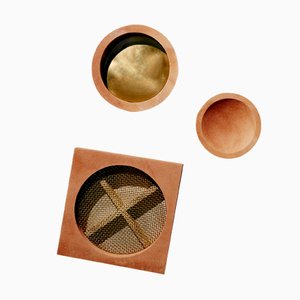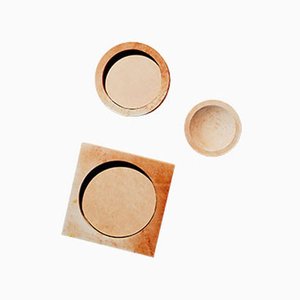Design from Down Under
Daast
Next month, the Australian National Craft Initiative will host a design and craft conference at the National Gallery of Victoria in Melbourne, and I’m super excited to have the opportunity to check it out. For the next few weeks, I’d like to gear up by celebrating all the talent Australia has to offer—starting with Daast, the Sydney-based multidisciplinary studio founded by Andrew Southwood-Jones and Alexander Kashin. The pair specializes in thoughtful designs that sport beautifully functional (and functionally beautiful) details. Read on to get better acquainted with these dynamite designers from down under.
Wava Carpenter: How did you both meet, and what drew you to work together?
Alex Kashin: We met while studying Architecture at the University of Technology Sydney. We were a bit bored with architectural studies and wanted to do something more hands on; something at smaller scale where you have more freedom and are able to turn your design ideas into real objects much faster.
WC: How do you collaborate together on projects? What’s your process like? Do you have different roles?
AK: Our projects are usually a result of a big creative argument. It's never easy to get from an initial idea to a final design for us because we have two very different creative minds and creative minds tend to clash. Nevertheless, that's exactly what forces us to improve on our own ideas and prove to the other one that it is worthwhile. It's very useful to have someone who can add objective criticism to your design process. It definitely makes you think harder.
WC: Your designs tend to hinge on well-engineered, innovative details. Can you walk us through what sets your work apart, for instance, with the Harpoon and Shrink collections and the Aligned Lamp?
AK: We always chase ideas and concepts rather than certain aesthetic or visual qualities. We don't want to have a certain style, instead we want to come up with good ideas that we are excited about. Sometimes it comes from certain materials (heat shrink tube for Shrink collection), sometimes from functionality (Harpoon joint), and sometimes from the overall experience of the object (Numeral). Quite often we try to merge the advantages of cutting edge design and fabrication tools with more traditional material based techniques. We try to be very agile with the way we think about design; it's never constant for us. It develops and changes together with the set of our skills, knowledge, and experience.
WC: What about some of your more experimental installations?
AK: We really like temporary installations because they give us even more freedom than object design; they’re usually more conceptual and abstract, which gives us a chance at artistic expression on the whole new level. It doesn't need to have a function; instead it just needs to translate your ideas and create a certain experience, or emotional message. We find it much harder than designing a functional object, and we really enjoy this type of challenge. Another great thing is the temporary nature of installation. It has very short life cycle, which makes it way more vivid and emotional.
WC: For those of us on the other side of the planet, what should we know about design in Australia right now?
AK: Hmmm… That's a hard one. I think the very fact of its existence will already be a surprise for most people. Australian design is fairly young and doesn't have a distinct heritage like Danish, Italian, or Dutch design. However, that's what makes it exciting. It's a blank canvas. We think that Australian design is only starting to form some sort of identity now, and it will take a bit of time before people can actually tell what sets it apart.
WC: What are you working on now? What’s next for you?
AK: We never work on one thing at a time. There is no start or finish to the design process for us. It's all about ideas that can be developed, transformed, and merged during the process. At the moment, we are working on a few small architectural products—doorstops, door hooks, etc. We really enjoy working at this scale where it's all about functionality; it's a new territory that we like exploring. At the same time, we are also working on a new lighting range, which is inspired by the movement of trains through subway tunnels. We also never stop testing heat shrink tube—it’s so fascinating, once you start shrinking stuff you can't stop. Hopefully something interesting will come out of these experiments.


